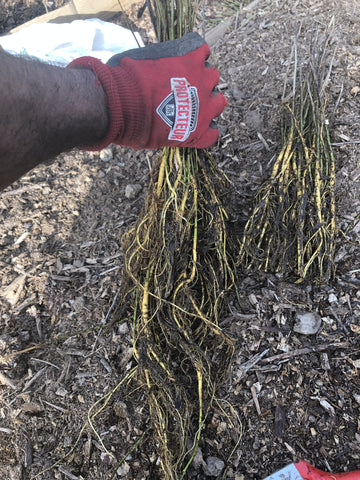What are the options for buying a tree.
When buying perennial plants there is a range of options that the plants come in. Potted trees and bareroot trees are a few of the popular ways trees come to you. Which one is the best? There are a number of factors to consider when making your choice of how you want to purchase a tree and I'm happy to explore how to make sense of it all.
Factors to consider
When purchasing a tree you might know why you want that exact tree but the context about your means for purchasing and planting are relevant to consider. Budget is an important factor when many 4 foot+ trees in pots can fetch more than $100 each. Your ethics surrounding their means of production are important as most nurseries selling potted trees use a lot of synthetic chemical fertilizers, herbicides and fungicides without feeling the need to share this with their customers. Ask your nursery hard questions about production. If they are just resellers chances are they got it from a much larger operation that employs these kinds of practices. Another factor to consider is root structure and long term damage. Some potted trees can recover from living inside a plastic pot very well, but many tap rooted and slow growing species develop strangled roots that can never recover and will eventually sputter out in a few years or result in slow long term growth. If you have a young tree that seemingly died all of a sudden dig up the root ball and examine if the roots ever made it out of the whole you stuck their root ball into.
Why so many potted trees?
Potted trees are the most common way folks purchase trees mostly because this is by far the most common way trees are available. Though this is not because this is whats best for the tree, or even the customer. Trees are commonly potted because the nursery industry as a whole is looking to maximize profits and mechanize production. Trees in pots are easier to pump full of fertilizers, can be sold during the growing season when customers can see the living plant and can be managed mechanically. That beautiful green growth is artificial to a real growing environment and has created an imbalance between top growth and root development. The potted nursery industry preys upon people's impatience when it comes to growing trees and offers larger trees in pots that are often root bound and grown in greenhouses or climates much warmer than where they end up being sold. If you have to buy a potted tree make sure its small (under 3 feet) and ask the grower where the genetic comes from and what was used to feed the tree.

Benefits of Bareroot
Bareroot trees offers growers the simplest most affordable way to establish a tree in their landscape. Bareroot trees are commonly grown in the field or air pruned environment and are more adaptable to growing in the soil in their final homes. These conditions result in vigorous root growth without adding too much top growth to the plant that make potted trees vulnerable to wind events, animal browse, and drought. The cost savings is also unrivaled because the farmer didn't have to pay for potting soil, plastic pots, synthetic fertilizers, greenhouses or any of the hidden cost implicit in a potted tree. When buying bareroot you are forced to plant during the dormant season which is significantly healthier for any woody perennial as opposed to surviving trauma to the root zone of a living plant while in the process of evapotranspiration during the growing season. Ordering trees online becomes an option giving you more access to a wider variety and adaptability of trees grown in your country, this is especially beneficial in Canada where producers and cold sourced genetics are key but somewhat rare to find locally.
Summary
- Bareroot trees are cheaper and more responsibly grown
- Bareroot trees can be sourced online, from small growers with regionally appropriate genetics
- Potted trees are so common because it easier for large chemical based operations to entice customers with green plant material
- Potted trees are commonly rootbound that can result in poor long term growth or death
- Ask for transparency in growing practices and genetic sources when buying a tree

